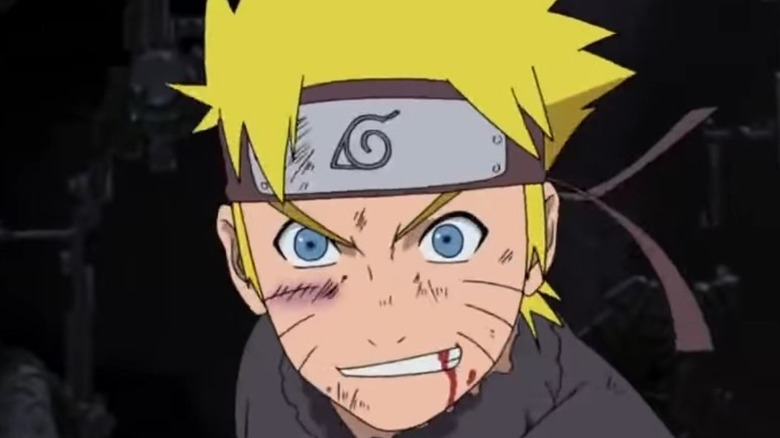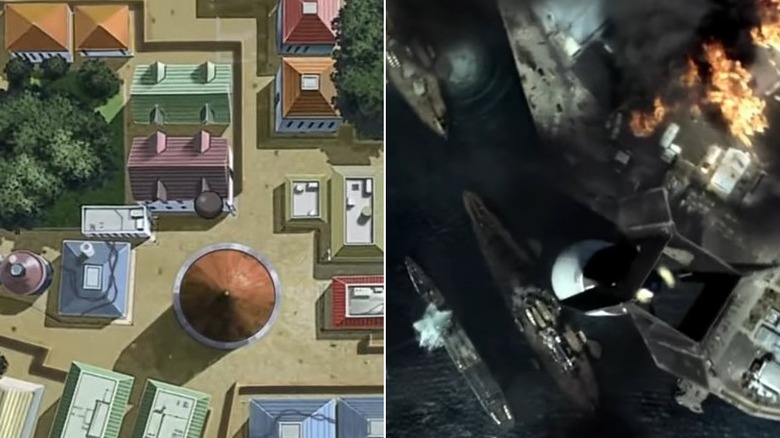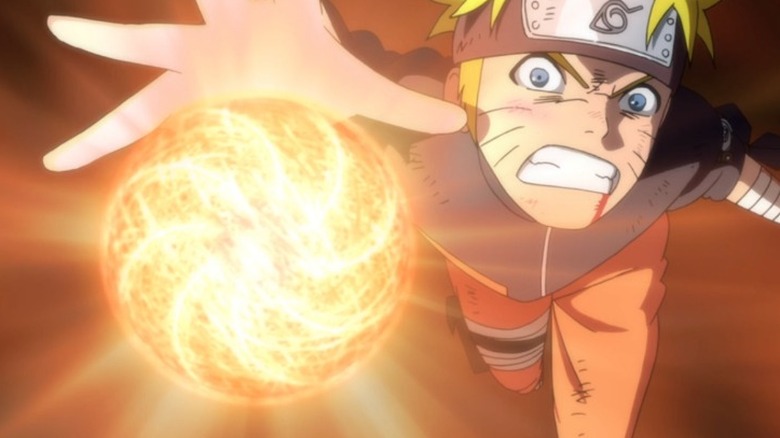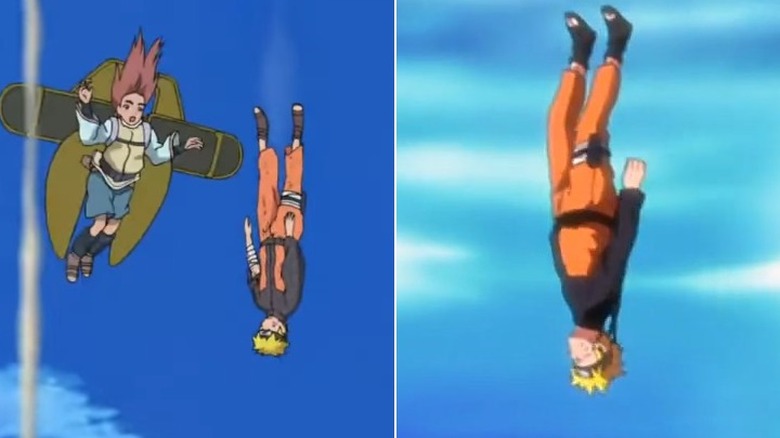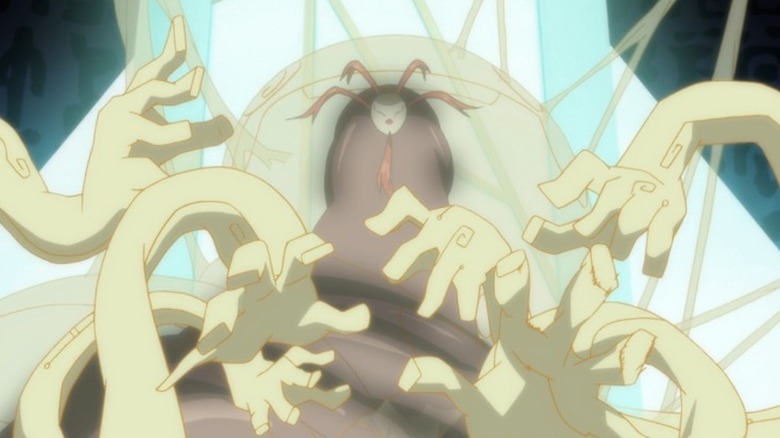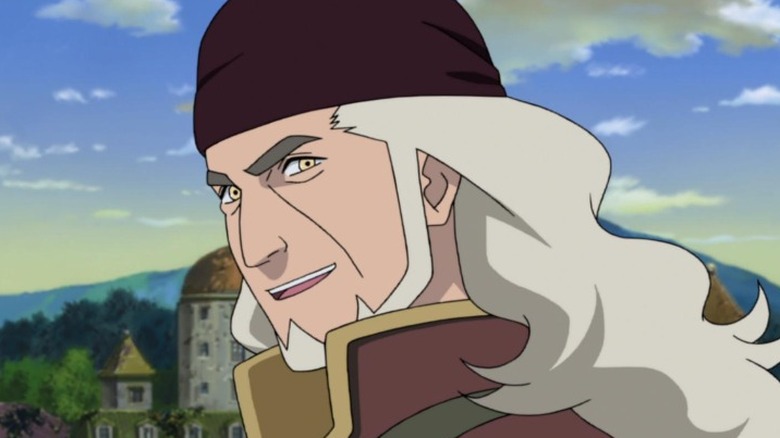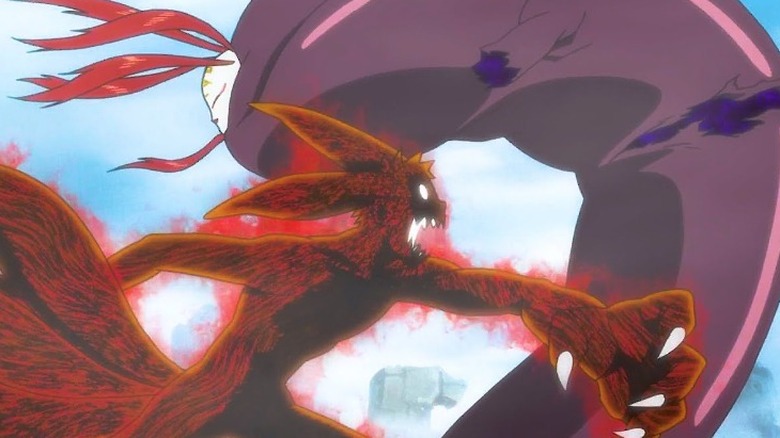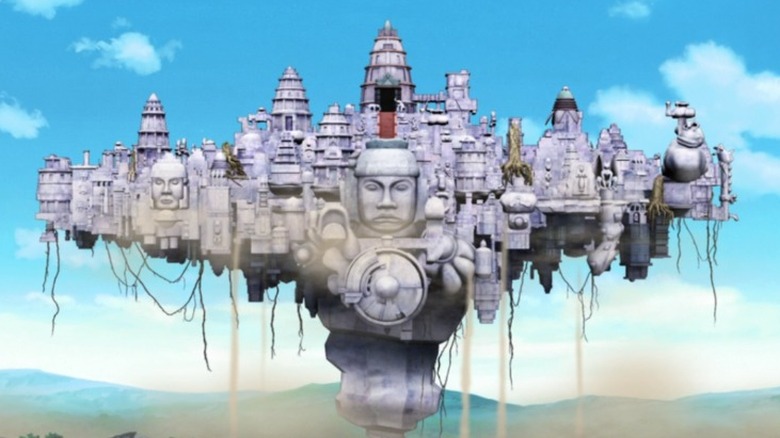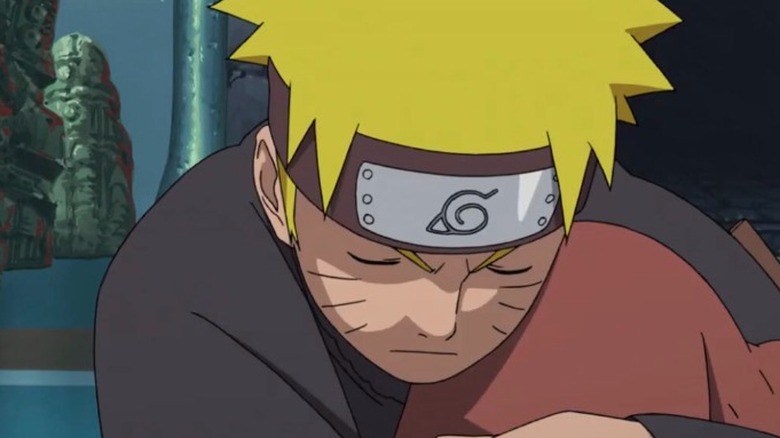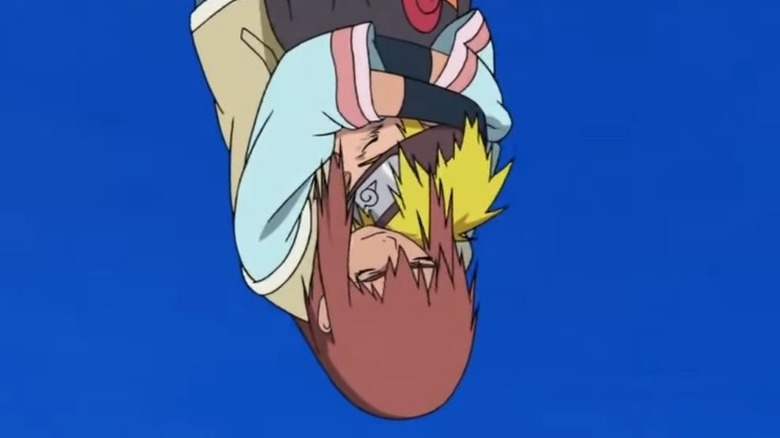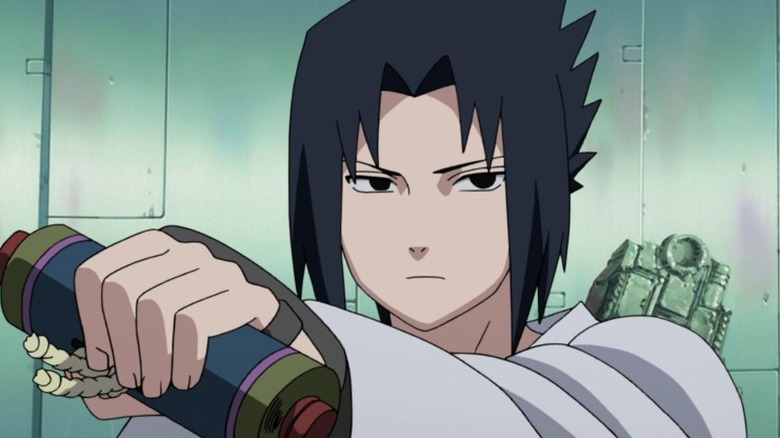Naruto Shippūden The Movie: Bonds Facts That Will Have Fans Coming Back For More
In 2008, "Naruto Shippūden the Movie: Bonds" was released in Japanese theaters. The fifth "Naruto" movie (but the second film to be based on the "Naruto Shippūden" anime series), it was unlike the first "Naruto Shippūden" movie in that it felt more canonical to the main storyline.
This is largely due to the tantalizing appearance of Sasuke Uchiha, absent from the previous film and embarking on a highly-anticipated reunion with Naruto Uzumaki. Even though "Naruto Shippūden the Movie: Bonds" is an anime-original story, talk of a mysterious Ten-Tails beast, references to previous events in "Naruto Shippūden," and appearances by Orochimaru — as miniscule as the screen time may be — make the film feel more true to the series than the threat of an ancient evil awakening in the first "Naruto Shippūden" movie. As with earlier films, two new characters are introduced in the movie: Doctor Shinnō and Amaru. Both make wildly different impressions on Naruto initially, and change drastically by the conclusion of the film.
While there are 11 "Naruto" movies to choose from, "Naruto Shippūden the Movie: Bonds" stands out for its brisk (albeit, too brisk at times) pace, heavy action, and heartwarming moments of love, respect, and dedication towards friends, family, and sensei. It's also pretty funny (the animation of Naruto transforming into his various teachers is a hoot), especially when the film pokes fun at the series' own cheesy message of friendship.
There is a lot of detail that went into this movie, some of which are not obvious at first glance. Below, a (spoiler-heavy) breakdown of things worth looking for in a second viewing.
The opening sky ninjas attack was lifted from Michael Bay's Pearl Harbor
"Naruto Shippuden the Movie" gets the ball rolling with a shocking image of Naruto being impaled by a demonic beast, his friends burying him mournfully at the Village Hidden in the Leaves. Even though it turns out that the cold opening is a mere premonition, the scene itself is shocking enough to hook viewers.
"Naruto Shippūden the Movie: Bonds" lure fans in with a similar shock; the Land of the Sky's assault on the Village Hidden in the Leaves.
Out of nowhere, ninjas from the Land of the Sky begin bombing the Village Hidden in the Leaves for their actions in the Second Shinobi World War. The Village Hidden in the Leaves (which is portrayed more city-like in the movie than in the anime and manga) is subjected to devastating attacks from the sky ninjas above, seemingly playing upon a viewer's memories of real-life, 9/11-like terrorist attacks.
The tragedy that actually inspired the sky ninja assault was not only much earlier, it was filtered through the lens of Hollywood's most renowned action filmmaker. In 2001, Michael Bay released his take on "Pearl Harbor," and the Ben Affleck flick was punctuated by many overhead, slow-motion, somewhat romanticized snapshots of that notorious day of infamy. Several scenes from the opening assault in "Naruto Shippuden the Movie" are nearly identical to Bay's action sequences. In particular, take a good look at the sky ninja dropping a bomb on a tower, which closely mirrors Bay's depiction of a bomb being dropped by the Ijn Zero upon a ship below.
Naruto performs two new Rasengan attacks
It wouldn't be a "Naruto" movie if Naruto Uzumaki didn't learn a new variation of his signature Rasengan attack.
In "Naruto Shippuden the Movie," Naruto was able to unleash the Super Chakra Rasengan to vanquish the demon Mōryō, thanks to the help of priestess Shion. In "Bonds," Naruto has two brand-new Rasengan up his sleeves: the Tornado Rasengan and the Guts Rasengan.
The Tornado Rasengan is used during Naruto's final assault on the Zero-Tails, and the Guts Rasengan is used when Naruto destroys the flying fortress, Ancor Vantian. As one would expect, there's no information regarding these two movie-exclusive moves — other than, well, they look really cool. However, the Guts Rasengan was inspired by Jiraiya's heartfelt talk with Naruto about what it means to be a ninja. Naruto, of course, takes Jiraiya's talk of a hero needing guts literally by using his Guts Rasengan to destroy the Ancor Vantian, so it wouldn't fall into the wrong hands again. It's an admirable move that nearly costs Naruto his life, as the destruction of the Ancor Vantian meant there would be no safe landing for Naruto. Thankfully, Amaru came back to give Naruto the emotional support he needed, while Jiraiya saved both their lives by summoning Gamabunta and his big, soft belly.
Naruto falling is similar to the third opening of Naruto Shippūden
The conclusion of the movie has Naruto Uzumaki seemingly falling to his death, after using his Shadow Clone Technique and Guts Rasengan to destroy the flying headquarters of the Land of the Sky. Ultimately, Amaru swoops in, making an attempt to rescue him before the two are ultimately saved by Jiraiya.
If the brief image of Naruto falling down from the sky feels familiar, it's because the third opening of "Naruto Shippūden" features a similar image. "Blue Bird," the third opening performed by Ikimonogakari, premiered in April of 2008 and ran from Episode 54 of "Naruto: Shippūden" to Episode 77. "Naruto Shippūden the Movie: Bonds" was released in August of 2008. While it's entirely possible that the connection is coincidental, it's also possible that one is intended to echo the other. Especially since "Blue Bird" and "Bonds" both emphasize the complex relationship between Naruto and Sasuke Uchiha. The scene of Naruto and Amaru falling together even has Naruto telling her about his relationship with Sasuke, before they land on Gamabunta's gargantuan gut.
Is the Zero Tails a real Ten-Tails beast?
One of the biggest revelations in "Bonds" is the existence of the Zero-Tails beast. Its appearance is reminiscent of a dark purple leech with a body shaped like a serpent.
From the first look at the Zero-Tails, it's difficult to not see its similarities to the No-Face spirit in "Spirited Away," as well as Koh the Face Stealer from "Avatar: The Last Airbender." The movie doesn't go too deep into the origin story of the Zero-Tails, other than saying the inhabitants of the Land of the Sky used the mythical beast to sense and harness the power of negative emotions in people's hearts, creating dark chakra energy.
All this begs a question: Is the Zero-Tails a real Ten-Tails beast? Well, there's no mention of a Zero-Tails beast being born with the original Chakra Monsters in the original source material, and there's been no elaboration of its existence since the release of "Bonds," so that seems unlikely. Despite being a non-canonical beast, the Zero-Tails is still a cool creature in concept, design, and execution. The name "Zero-Tails" is also a clever way of acknowledging its non-connection to the Tailed Beast while using the moniker for legitimacy. It's also a better supernatural threat than an ancient evil no one in the series has ever spoken about before or after (sorry, Mōryō).
The meaning behind the name Shinnō
Doctor Shinnō is a wolf in sheep's clothing. In the beginning of the film, Shinnō presents himself as a kind, gentle soul who only cares about healing the wounded and raising his apprentice Amarau right. By half-time, the sheep clothes come off.
It is revealed that Shinnō staged his own death in a way that Amarau would bear responsibility, in order to bring her to despair, allowing the Zero-Tails to feed off her negative emotions and possess her. At the Ancor Vantian, Shinnō spills the ugly truth. He never cared about Amaru or her village. He only cared about manipulating her to feed the Zero-Tails the dark chakra inside her to unleash the monster's full potential.
Despite multiple opportunities to repent, Shinnō stubbornly remains a power-hungry tyrant till the bitter end, where the Zero-Tails burst forth. Whether you buy Shinnō's goody-two-shoes act from the beginning or not, the revelation of Shinnō's true nature is a major turn for the movie.
But what viewers might not realize is that there was a hint of his hidden god-complex all along. The name "Shinnō" (神農) means "God." It can also be translated to "Divine Farmer," which is referencing "Shennong," also known as Jiang Shinian, the mythological Chinese ruler known as the first Yan Emperor who became a deity in Chinese and Vietnamese folk religion.
Dark Chakra
Coinciding with the reveal of the Zero-Tails, dark chakra is a brand new chakra energy introduced in the animated world of "Naruto." The movie has a pretty straightforward explanation of the new chakra element. Dark Chakra is the negative energy collected from humanity when they're in a state of anger or despair. An example of this is Amaru being possessed by the Zero-Tails after believing she caused her mentor's death.
The initial fight scene between Naruto Uzumaki and the Zero-Tails is an interesting one, as the Zero-Tail is indulging on the negative emotions coursing through Amarau, while Naruto is fighting back the urge to use his unlimited chakra energy from the Nine-Tails, after previously nearly losing control and coming dangerously close to destroying his friends. Ultimately, a low-blow reference to his inability to save friend Sasuke Uchiha causes Naruto to unleash his four-tailed form.
While Naruto is ultimately able to regain his senses after a trinket from master Jiraiya reminds him of his humanity, the same power struggle is repeated again with Naruto fighting against a buffed-up Shinnō. While Shinnō overpowers him for most of the fight, Naruto's dedication to protecting Amarau gives him the strength he requires to put the doctor in his place.
The Land of the Sky
Who are the ninjas of the Land of the Sky? Well, based on their aerial assault on the Village Hidden in the Leaves, they're anything but peaceful.
According to Lady Tsunade's words, the Land of the Sky is a country formed by ninjas of several countries, who learned who to turn their chakra into mist to give themselves the ability to fly. Their prime directive back then (and now) was the destruction of the Five Great Shinobi Countries; the Village Hidden in the Leaves desecrated them during the Second Shinobi World War.
As one would expect, their surprise attack on the Village Hidden in the Leaves in predicated upon all that. Just based on their aerial assault performing like warplanes and the naval ships they had waiting in the back, the Land of the Sky is a highly-militarized country. That's not even taking into account their supernatural weaponry, such as their deployment of the Nine-Tails and the flying fortress, Ancor Vantian, powered by dark chakra.
The Ancor Vantian ("Fortress of the Empire") is shown to be the greatest technological achievement of the Land of the Sky, as well as their most dangerous weapon of mass destruction, as its laser-like armaments blast through a mountain and sweep a large portion of the ocean to annihilate one of its own armada. The downside to all this is that the Land of the Sky never truly has full control over the Zero-Tails and its infusion of dark chakra — as demonstrated by the demonic beast wiping out the sky ninjas that inhabited Ancor Vantian after Shinnō was no longer its vessel.
The bonds in Bonds
While so many twists, turns, and set pieces happen throughout "Naruto Shippuden the Movie: Bonds," there is one thing that connects everything together: the bond one forms with someone they love and respect. While the "Naruto" anime series has always championed friendship and love, "Bonds" focuses on the relationship between a student and mentor.
Naruto Uzumaki never got to experience the love of his father, Minato Namikaze, but was able to find solid father figures in his life via Iruka Umino, Kakashi Hatake, and Jiraiya. All three gave Naruto the support, discipline, and education he needed to become the great Hokage he is today. Most importantly, they gave his life a purpose.
That's also what Amaru had in Doctor Shinnō. Before the betrayal, Shinnō saved Amaru's life from a mysterious disease that isolated her from her fellow villagers. As an orphan, Amaru only knew about love and support from Shinnō, who trained her to use her scalpel to heal, never as a weapon of war. It's why the reveal that Shinnō never cared about her nearly drove her to suicide. However, Naruto was there to stop her from self-harm, saying that even though Shinnō himself is a detestable man, the morals he instilled in her retain value. It's there that Amarau is able to forge a new, healthier bond with Naruto.
Naruto x Amaru
Perhaps the greatest thing about "Bonds" is the development of a significant relationship between Amaru and Naruto Uzumaki.
At the beginning of the film, Amaru is quick to butt heads with Naruto for his ninja profession and for questioning her mentor, Doctor Shinnō. Naruto, being Naruto, acts returns her immaturity.
Naruto's view on Amaru, however, changes once he realizes how much Shinnō means to her, to the point that she may have a crush on the old doctor. (Things also get awkward for Naruto when he realizes that Amaru is actually a girl under her tomboy garb. Which makes the scene of her sucking and spitting out poison from his leg even more uncomfortable). Amaru's view on Naruto changes for the better when she sees how dedicated he is to protecting her from the harm that Shinnō's betrayal caused. He stood up for her against Shinnō's cruel words, saved her life when she nearly committed suicide, and encouraged her to finally express her feelings for Shinnō, even if they fell on deaf ears. Naruto was the supportive mentor Amaru thought she had in Shinnō. It's no wonder that by the end of the film, Amaru is willing to die with Naruto, and begins to blush when she holds him in her arms.
Sasuke
There is little denying that the major selling point to "Naruto Shippuden the Movie: Bonds" is the appearance of Sasuke Uchiha.
Missing in action in the previous "Naruto" movie, and at the time of the new movie's release, he wasn't a major player in the "Naruto Shippuden" TV series. So, this is the perfect opportunity to see Sasuke in action again, as well as have him partner up with his former friend Naruto Uzumaki. Sasuke's arrival also fits the theme of bonds in "Naruto Shippuden the Movie: Bonds." Despite Sasuke's betrayal of the Village Hidden in the Leaves, Naruto never lost faith in his former rival. Even with his affiliation with Orochimaru, Naruto is thrilled to see Sasuke again, and even separates himself from him when he attempts to take down the flying fortress of the Land of the Sky by himself.
Sasuke, in typical Sasuke fashion, expresses no joy or hard feelings towards Naruto when their paths collide. In fact, he even helps Naruto take down the Zero-Tails after securing the resurrection scroll for Orochimaru. The movie is quite careful in making sure Sasuke isn't shown being buddy-buddy with Naruto, while also making sure he isn't entirely cold to him. The most telling part of Sasuke's brief reunion with Naruto, it seems, is neither confirming or denying he had fun on his mission. And, of course, there's also Sasuke remembering Naruto's vow to bring him back home, before unleashing a Chidori attack to take the movie out.
